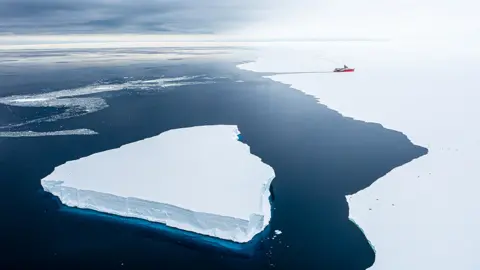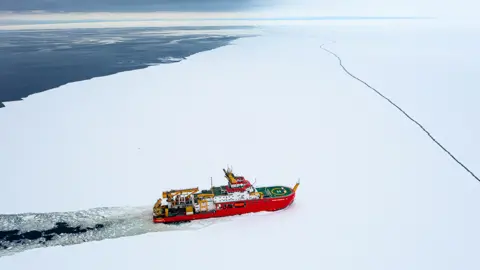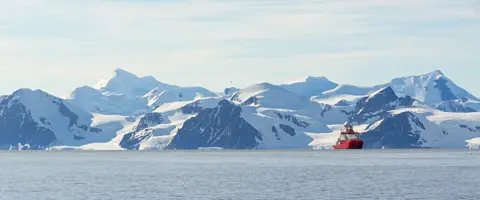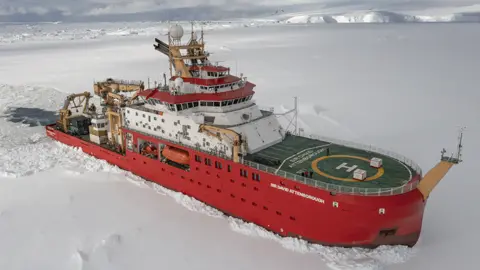Attenborough ship proves its polar credentials

The new Royal Research Ship (RRS) Sir David Attenborough is proving its capabilities as an icebreaker.
On its first outing to the Antarctic, the £200m polar vessel - popularly known as Boaty McBoatface - has been smashing through thick frozen floes.
A final assessment of its performance is still awaited, but the Attenborough is now very close to being declared a fully serviceable ship for science and logistics at the highest latitudes.
The vessel will soon return to the UK.
For the moment it continues to work around the White Continent. When it does come back, it will go into a yard for maintenance and upgrades.
 Jamie Anderson/BAS
Jamie Anderson/BASThe Sir David Attenborough (SDA) went through formal ice trials during a 10-day period in January. The British Antarctic Survey (BAS) engaged Finnish engineering consultants Aker Arctic to oversee the work.
The trials involved pushing the ship through floes at various power levels. The vessel also had to perform a range of manoeuvres, including reversing, turning, as well conducting impact tests at different speeds.
RRS Sir David Attenborough is what's called a Polar Ice Class 5 (PC5) ship, meaning it should be able to move through medium, first-year ice - about a metre in thickness - at a speed of three knots (3.4mph; 5.6km/h).
 Jamie Anderson/BAS
Jamie Anderson/BASBAS scientist Dr Andrew Fleming said the ship managed well these and more difficult conditions. At times in recent weeks the Attenborough has been cutting through 2m-thick floes.
"Producing the final assessment takes some work to adjust for ice that was a bit warm and snow that was a bit thick," he told BBC News.
"It was an anomalous year across a lot of the Antarctic and in places we did not expect a combination of second-year ice plus 1.5m of snow. That's extremely challenging for any ship.
"But we certainly got a good sense of how the new ship performs in a wide range of sea-ice conditions and ultimately this is about learning how best to operate SDA."
Part of Dr Fleming's role was to find the "right ice" in which to test the ship. He used satellite data for this search, but ultimately had to climb down on to the sea-ice to drill through it to check its suitability.
Prof Dame Jane Francis, the director of BAS, said she was delighted with the ship's performance in the ice.
"It's been quite special to see the stunning footage of our big red ship surrounded by snow and ice for the first time. It is something we have all imagined, right from our initial conversations about the ship, and so it's a very poignant moment to finally see it in the ice."
 Jamie Anderson/BAS
Jamie Anderson/BASDr Fleming added: "You might imagine that a ship crunching and banging through ice is a noisy and uncomfortable experience, but my memory of this time on SDA is a much quieter and gentle experience.
"Perhaps it is the size of the ship or the large amounts of snow cushioning the impact, but it felt more like firmly pushing through the ice rather than the jarring, shake-rattle-and-roll that I've experienced before. Add to that the wonderful silence when working on the ice miles away from the ship and you have a much more muted but powerful experience."
 Alex Wallace/BAS
Alex Wallace/BASSome design modifications to the ship will be required following the Attenborough's maiden expedition. It was found, for example, that seawater intakes for making fresh water became blocked with ice on occasions. An engineering solution will be devised to prevent this from happening in the future.
Also, one of the two rudders was knocked out of alignment when backing into heavy sea-ice. This doesn't affect the safety of the ship but the rudder will need to be realigned during the refit period.
 Andreas Cziferszky/BAS
Andreas Cziferszky/BAS